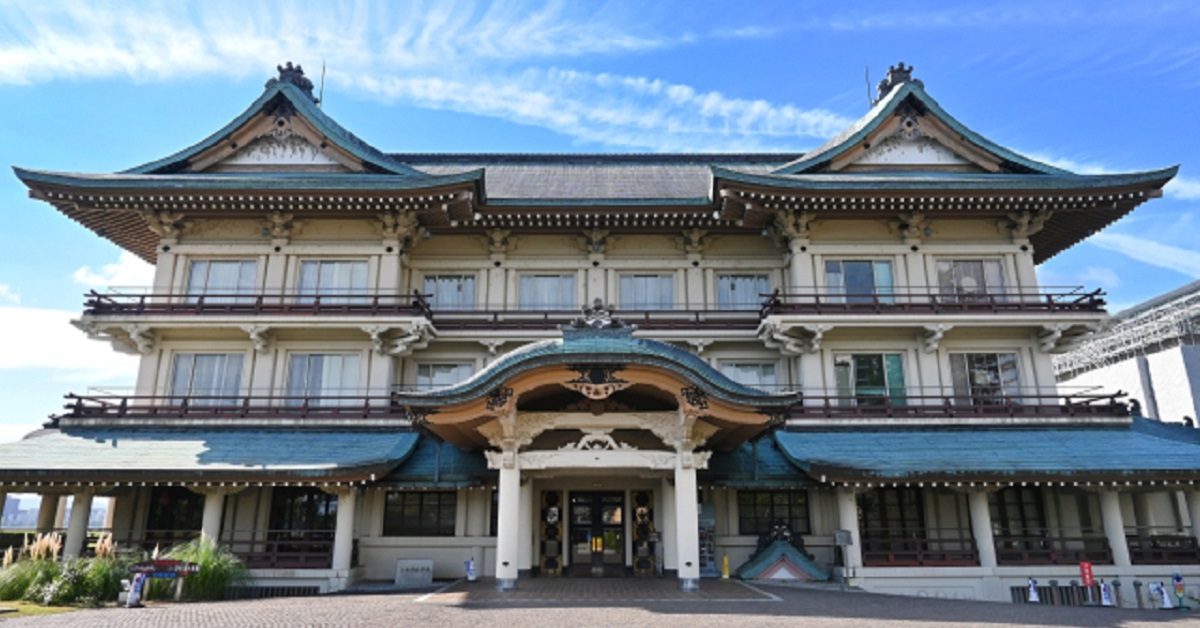Located in Otsu City, Shiga Prefecture, Biwako Otsukan played a central role in the movie KOKUHO as the Kabuki theater “Hinomotoza.” The building, originally the former Lake Biwa Hotel, showcases stunning Momoyama-style architecture and was chosen for its majestic appearance. Today, it serves as both a cultural landmark and a tourist destination, allowing visitors to relive cinematic history while appreciating traditional Japanese design.
The History of Biwako Otsukan
The former Lake Biwa Hotel Main Building, which opened in 1934, was praised as “the guesthouse of Kansai.” It welcomed both domestic and international dignitaries and became a symbol of Lake Biwa tourism. With its white walls and red tiles reflecting beautifully on the lakeside, the building still retains its charm today.
In 2001, it was redeveloped into a public cultural facility and renamed Biwako Otsukan. Today, it serves as a place of relaxation for local residents as well as a cultural site for visitors.
KOKUHO and the Appearance of Hinomotoza
In the movie KOKUHO, Biwako Otsukan played a significant role as the Kabuki theater “Hinomotoza.” Especially in the scenes of the theater’s exterior and the rehearsals in the lobby, the architecture added weight and atmosphere to the film.
By placing a traditional art form like Kabuki against the backdrop of historical architecture, the film achieved a deep sense of immersion for viewers. The building functioned as more than just a filming location; it elevated the overall artistic quality of the movie.
Momoyama Style and Its Connection to the Kabuki-za
The exterior of Biwako Otsukan reflects Momoyama-period architecture, known for its robustness and decorative grandeur. These qualities resonate with the atmosphere of the Kabuki-za theater in Tokyo.
| Item | Biwako Otsukan | Kabuki-za |
|---|---|---|
| Exterior | White walls and red-tiled Momoyama style | Traditional Japanese style |
| Atmosphere | Solemn, cultural hub for tourism | Prestigious symbol of performing arts |
| Function | From luxury hotel to public cultural facility | Main venue for Kabuki performances |
| Role in film | Background for theater exterior and rehearsal scenes | Symbol of Kabuki culture |
Appeal as a Tourist Destination
Beyond being a film location, Biwako Otsukan functions as a multi-purpose cultural and tourist facility. It features a restaurant with panoramic views of Lake Biwa and gardens filled with seasonal flowers, making it a popular attraction.
It also houses a wedding venue and conference rooms, balancing its historic value with modern usage.
Features of the Facility
| Facility | Feature | Purpose |
|---|---|---|
| Restaurant | Meals with a view of Lake Biwa | Tourism and special occasions |
| Garden | Seasonal flowers in bloom | Walks, photography |
| Wedding Hall | Historic building as a backdrop | Ceremonial occasions |
| Conference Rooms | Preserved historical atmosphere | Corporate and community events |
Access and Nearby Attractions
Biwako Otsukan is centrally located in Otsu and is easily accessible. From JR Otsu Station or Keihan Railway, it takes about 10 minutes by bus.
Nearby, visitors can explore historic temples such as Enryaku-ji, Ishiyama-dera, and Miidera, making it easy to combine a visit to Biwako Otsukan with a cultural tour of Shiga.
Recommended Nearby Attractions
| Destination | Feature | Travel Time |
|---|---|---|
| Enryaku-ji | UNESCO World Heritage temple on Mt. Hiei | 30 minutes by car |
| Ishiyama-dera | Temple associated with Murasaki Shikibu | 20 minutes by car |
| Miidera | Head temple of the Tendai Jimon sect | 15 minutes by car |
| Lake Biwa Cruise | Scenic view from the lake | Within walking distance |
Cultural and Economic Impact
The use of Biwako Otsukan as a filming location has increased its cultural value while also revitalizing the local economy. Tourists who come to see the film location also spend at local restaurants and hotels, providing direct economic benefits.
For visitors, experiencing the actual scenes from the movie enhances satisfaction and encourages repeat visits, strengthening regional tourism.
Impact on the Local Community
| Impact | Example |
|---|---|
| Economic | Growth in dining and lodging demand |
| Cultural | Reappraisal of historical architecture and film culture |
| Educational | Opportunities for young people to engage with tradition |
| Social | Pride among locals and stronger cultural identity |
Conclusion
In the movie KOKUHO, Biwako Otsukan appeared as the Kabuki theater “Hinomotoza”, leaving a strong impression nationwide. Its Momoyama-style architecture added depth to the narrative and resonated with the spirit of Kabuki.
Today, it stands as a cultural and touristic landmark cherished by both locals and visitors. With its combination of film heritage, historical architecture, and scenic Lake Biwa, Biwako Otsukan continues to shine as one of Shiga’s most iconic sites.
A visit here allows travelers to experience the intersection of cinema, history, and culture, making it a must-see destination for anyone exploring Shiga.






